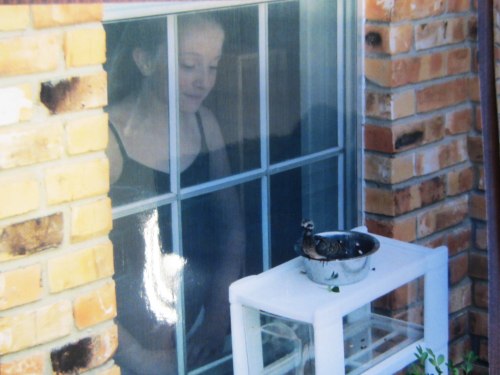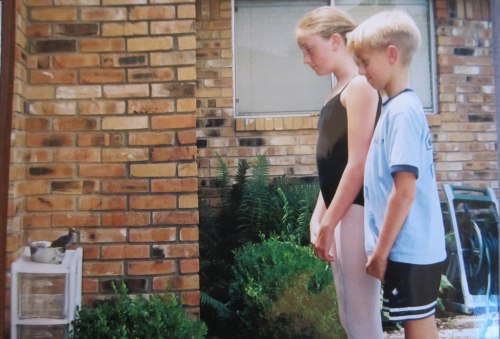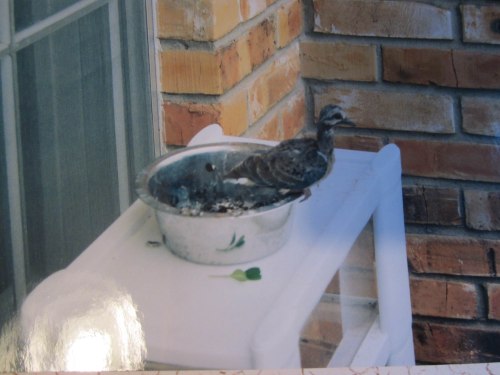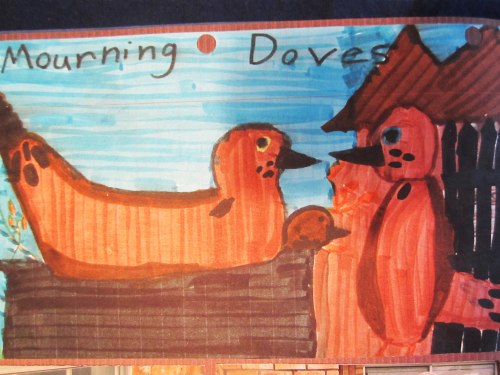A new friend of mine told the story of how a wild animal tore through their chicken coop and destroyed 9 of their new chickens. Nine. Enough to create havoc in their yard. Enough to create havoc in their hearts. And in the middle of this massacre was their 7 year old daughter. She rescued one survivor, giving it the care that only a child can give. Only after its wounds were tended did she allow herself to feel the pain of the events. She allowed herself to grieve the loss, the pain, the violation.
This story sent me to a place of thinking through how we as parents can help our kids through the grieving process.
When my kids were little (probably 5, 6, 8 and 11), we disturbed a nest. It was sheer accident, in the midst of cleaning out some planters in our backyard. When the planter was tipped upside down, out tumbled two baby birds. One died immediately, but the other looked like it could be saved. We grabbed a towel, and as gingerly as we could, lifted it into the first container we could find. We set the bowl outside, right by our living room window, and waited. We willed that mama bird to return to it. We saw her on our roof, and while she clearly was watching the baby closely, she didn’t swoop down to help it. The minutes of watching turned into hours, and still, we sat by our window praying that she would defy the odds and come tend to her baby.
Around 4 hours later, the mama took the risk that we’d been longing for and landed on the container. She looked over the baby, and then flew off to get food. We sat mesmerized and studied every little movement. We studied their markings closely, and with the help of the internet, were able to determine that these were mourning doves. For days and days, this was the focal point of our lives. We learned that, within the mourning dove species, both the mama AND the papa care for the babies. With a front row seat, we watched how the baby was fed, we watched how the mom and dad worked together, we saw the baby transform from a little blob of flesh to one with beautiful feathers. Daily, we thanked God for this National Geographic moment that we were allowed to experience. Over about 2 weeks, we watched the baby get stronger, practice flapping its wings, step out on the ledge, only to tire and rest once again in the container. We watched its parents encourage it to be brave enough to try flight. On the day that it flew for the first time, its mom and dad were on both of our neighbor’s roofs calling out to it to fly. We literally had lawn chairs set out, not dreaming of missing one second of this miracle, and cheered loudly as it finally took off.
The first flight was short (about 15 feet), and we actually had to help it back into the container so that our dog couldn’t get to it. Over the next few days, we lovingly watched our baby get stronger and stronger, attempting longer flights. We always kept our eyes on it so that we could retrieve it and protect it from neighborhood animals. One day, when my eldest and I didn’t find the baby in its container, we scoured the backyard looking for it. With a little melancholy, believing that our baby had finally flown out of our yard, we walked the backyards of our neighbors to see if we could see where it had ended up. Without ever finding it, but being satisfied that it had finally become independent, we went back inside.
About an hour later, my eldest walked towards me from the backyard with absolute horror on her face. She could barely speak as she told me that she saw our dog “playing” with something underneath our trampoline that looked like our baby. I ran outside praying that she was wrong, only to confirm that our Jack Russell, doing what Jack Russells do, had found the bird. and. killed. it.
As I gathered the kids to tell them the news that I could hardly get out through all of my tears, we all huddled together on the couch, one giant puddle of emotions and agony. We literally spent hours on the couch crying and grieving. When the tears were dried up, the kids collectively decided to bury the baby, placing around the grave some of their favorite things. They came back inside and drew pictures as tribute to the little life that they had loved.
Fast forward about 9 years, and my husband and I make a decision to move across the country. I now am in the position of helping my kids through the grieving process of leaving their best friends, their areas of comfort and familiarity, and a culture and region of the country that they loved. There are many ways to describe the process that they’re going through (transitioning, enduring change, learning to integrate), but from what I’ve seen, the easiest way to categorize the process is grieving. Even if they look great on the outside, there are still areas of loneliness, loss, and hurt that they’re experiencing.
Whether it is over a death of a pet, the process of leaving something familiar and precious, or not getting an award or part they really wanted and worked for, all kids grieve. There are lots of articles on the internet about the steps of grief, about the process of grieving, and even how to handle those who are grieving, but walking through grief with your kids is a whole other matter. The rules and tips seem to fall way short when you’re watching your kids cry.
Here is what I’ve done.
The first seems obvious. Listen. Take time to give the child your full attention. As long as it takes, and as often as needed. I assure them that we can pull aside to talk over and over if they need it. I assure them that they are not a burden, their emotions aren’t overwhelming to me, and that I am willing to completely walk through this with them.
Talk through options of how to deal with the situation. It might be that changes need to be made in routine or schedules. Ask them what things that you as a family might have stopped doing that would bring them comfort. If applicable, it might be that they need encouragement to try again, whether that is trying out for a team or an award, or whether that is in the area of friendships.
Often times, kids express grief through wide mood swings. On a normal day mood swings can be annoying, but especially if you’re struggling with sad feelings. Often times, grieving doesn’t feel natural to a child because it is difficult to control emotions, thoughts and feelings surrounding the loss. Especially to a child who is used to feeling in control of themselves, the sense of being out of control that is often a part of grief may frighten some kids. Pointing this out, talking about the struggles that sadness causes, and giving your kids a safe place to express themselves, is really important.
Create a shared Gratitude Journal. Reminding kids of what they’re thankful for goes a long way to help them take their eyes off their loss. In the case of one of my kids, they were carrying a vague feeling of sadness without being able to point to any specific thing. We began recording 5 things daily for which we were thankful, placing them on each other’s pillows to help celebrate the good things that happened throughout the day. This helped them to refocus those vague, negative emotions onto the tangible, experienced positive things.
Grief is personal to everyone. There are no easy answers, and there is certainly not only one correct way to deal with loss. I hope that these ideas help you provide for your kids a place where they can fully be themselves, at the same time helping them envision a positive future.








Reblogged this on precariousyates and commented:
The story at the beginning is about my brave, sweet Kenzie.
Another timely message, as my four year old is playing in his room and my 29 year old is waiting in agony for Weds when the oncologist will tell them if there is any point or hope in chemotherapy for her husband. Thank you.
My breath caught as I read this comment. I am so sorry for the anxiety, the waiting, and the ugliness of cancer. I am humbled that you took the time to comment, and please know that I will be praying for your family. Not just words – I’ll really be praying…
Found you through Simple Homeschool. The thing I particularly liked about this post is your suggestion of the gratitude journal. Someone told me she would do this with her kids when they were sad about moving, by asking “what are some things we can do in our new home that we couldn’t in our old home?” I have been helping my older two (6 and 4) to do their own gratitude journals for the past few months but I hadn’t thought about it in connection with grief. The mother of a family close to ours just lost her battle with cancer and I am trying hard to be real with them about my grief and theirs at the same time.
I also echo your point about grief being so different. My daughter has been expressing her saddness more “normally” through tears and comfort seeking but my son has been acting like a twerp. 🙂 even to the point of getting whiny and irritating at the graveside service. Soo important for me to remember that this behavior can be grief as well, for little boys especially.
thank you for sharing.
Unbelievably humbling. Thanks so much for taking the time to comment, and I am so glad that what we’ve lived through and experimented with helped someone. I am so sorry for your loss. I sat and read the online journal of your friend’s walk through cancer and wept. What a loss. Thanks again for commenting, and I’ll be praying for you, your family, and her family as you all heal.
I am touched that you took the time to read her journal. Thank you. What a story. . . who knows what God will do/has done with it!
Pingback: Helping Children with Grief | Homeschooling Our...